|
|
|
Sort Order |
|
|
|
Items / Page
|
|
|
|
|
|
|
| Srl | Item |
| 1 |
ID:
130717
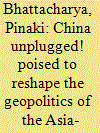

|
|
|
|
|
| Publication |
2014.
|
| Summary/Abstract |
Within the first year of Xi Jinping's elevation to the presidency, China has moved further ahead on its path to achieving primacy in the world. In the last week of November 2013, Beijing imposed an Air Defence Identification Zone (ADIZ) over the conflicted Diaoyu/Senkaku Islands in the East China Sea, much to the consternation of its feuding neighbours such as Japan and South Korea. Their howls of protest found expression in the US attempt to challenge China to promulgate what it has done in deed.
|
|
|
|
|
|
|
|
|
|
|
|
|
|
|
|
| 2 |
ID:
157808
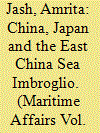

|
|
|
|
|
| Summary/Abstract |
The East China Sea dispute has become a characteristic feature in the defined “hot economics, cold politics” relations between China and Japan. The maritime sphere has gained precedence in the larger realm of diplomacy, thus making the contested waters a primary hotspot of power politics between the two Asian countries. With the growing tensions, in all likelihood the maritime dispute will be high on the political and security agenda of China and Japan. What makes this worrisome is that the dispute does not just make the bilateral relations unstable but holds significant implications for East Asia’s regional stability. In this regard, given the phenomenon of constant testing of each other’s resolve, the possibility of an all-out confrontation in the East China Sea remains a vital concern. What has further added to the power struggle is the US involvement, thus making the dispute a difficult case to resolve. The crux of the paper lies in understanding the volatility of the East China Sea dispute between China and Japan. In doing so, the paper examines the determinants of the dispute, the actors involved and their responses.
|
|
|
|
|
|
|
|
|
|
|
|
|
|
|
|
| 3 |
ID:
194347


|
|
|
|
|
| Summary/Abstract |
The dispute over the Diaoyu/Senkaku Islands is generally analysed as a Sino-Japanese competition over material and strategic interests, regional preponderance, and nationalistic symbolism. Yet, such explanations cannot fully explain the endurance of the conflict and overlook its origin in the period leading up to the UN’s derecognition of Taiwan’s sovereignty in 1971. Drawing on the concept of ontological security, defined as ‘security of the self’, we contend that it was the looming loss of its sovereign self that prompted Taiwan (Republic of China, ROC) to assert itself as the true defender of Chinese interests by laying claim to the islands. This caused anxiety in China (People’s Republic of China, PRC), which had to follow suit in order to secure its own sovereign self. China thus inherited the conflict with Japan when it took over the ‘true China’ mantle upon its entry to the UN in 1971. Extant explanations overlook the important factor of inter-Chinese competition over sovereign selfhood. In developing this argument, the article makes two contributions. First, it draws attention to a much-overlooked early phase of the dispute, and shows how the same dynamics of ROC–PRC status competition continue to inform the dispute between China and Japan today. Second, it contributes to the literature on ontological security by conceptualising the ‘self’ as sovereign state personhood, thereby further clarifying the distinction between self and identity, and highlighting the relational effects of ontological security-seeking.
|
|
|
|
|
|
|
|
|
|
|
|
|
|
|
|
| 4 |
ID:
183519
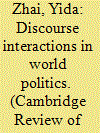

|
|
|
|
|
| Summary/Abstract |
Discourse, as a constructive power, plays a significant role in world politics. Rather than focusing on the formation or transformation of a single discourse, we investigate discourse interaction in the context of multiple competing discourses. Based on the theories of discourse interaction, this study analyses the realist dimension of discourse by examining the territorial dispute between China and Japan over the Diaoyu/Senkaku islands and shows how the two countries use discourses to pursue their own security and respective realist interests. This analysis identifies five major controversies in the two countries’ discourses on their claims of sovereignty over the islands and demonstrates that each of the two states uses both complementary and competing discourses to strengthen its own stance and delegitimize the other’s claims. The theoretical analysis of discourse interaction not only contributes to the growing research on discourse practices in IR, but also has important implications for practice-oriented strategic communication.
|
|
|
|
|
|
|
|
|
|
|
|
|
|
|
|
| 5 |
ID:
154652
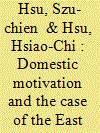

|
|
|
|
|
| Summary/Abstract |
China's declaration of an air defense identification zone (ADIZ) in the East China Sea shocked the international community, and many explanations have been offered about the motivation behind it. We argue that domestic politics played a key role in the ADIZ policy. However, existing studies have not paid sufficient attention to decisionmakers' political motivation. To fill this gap, we explore two distinct models: the diversionary foreign policy model and the mobilization model. Both models focus on the linkage between the state leader's domestic political consideration and foreign policy behavior, but each has different theoretical and empirical implications. Our findings suggest that the mobilization model offers a better explanation of the motivation for China's move.
|
|
|
|
|
|
|
|
|
|
|
|
|
|
|
|
| 6 |
ID:
125976
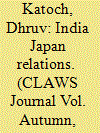

|
|
|
| 7 |
ID:
112434
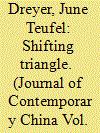

|
|
|
|
|
| Publication |
2012.
|
| Summary/Abstract |
The September 2010 collision between a Chinese fishing boat and a Japanese coast guard ship showed the ambiguities in American policy on the Diaoyu/Senkaku Islands. On the one hand, Washington has said that it takes no position on the sovereignty of the islands; on the other, it is bound by the terms of the US-Japan security treaty to defend the islands. In a larger context, the incident highlighted a geopolitical dilemma for Japan: how to position itself between a rising China and a United States that seems to be in a state of decline. China, on the rise, seems to be testing its role with regard to the other two powers. The United States, which also sees itself in decline, is asking similar questions. The waxing and waning power of Russia exerts additional counter-pressures.
|
|
|
|
|
|
|
|
|
|
|
|
|
|
|
|
| 8 |
ID:
172424
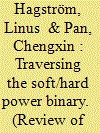

|
|
|
|
|
| Summary/Abstract |
Soft power and hard power are conceptualised in International Relations as empirically and normatively dichotomous, and practically opposite – one intangible, attractive, and legitimate, the other tangible, coercive, and less legitimate. This article critiques this binary conceptualisation, arguing that it is discursively constructed with and for the construction of Self and Other. It further demonstrates that practices commonly labelled and understood as soft power and hard power are closely interconnected. Best understood as ‘representational force’ and ‘physical force’ respectively, soft and hard power intertwine through the operation of productive and disciplinary forms of power. We illustrate this argument by analysing the Sino-Japanese dispute over the Diaoyu/Senkaku Islands. Both governments exercise representational force in constructing their respective versions of events and Self/Other. The soft/hard power binary itself plays a performative role as the Self is typically associated with soft power and the Other with hard power. The operation of productive power, moreover, privileges the attractiveness of the former and the repellence of the latter, and disciplinary power physically enforces these distinctions on subjects in both states. Finally, reinforced Self/Other distinctions legitimise preparations for violence against the Other on both sides, thus exposing how fundamentally entangled soft and hard power are in practice.
|
|
|
|
|
|
|
|
|
|
|
|
|
|
|
|
|
|
|
|
|